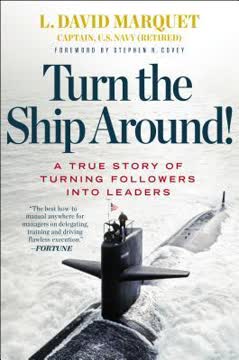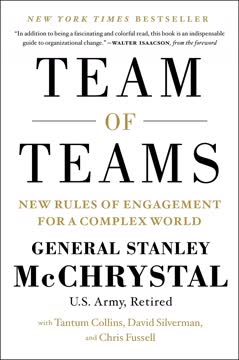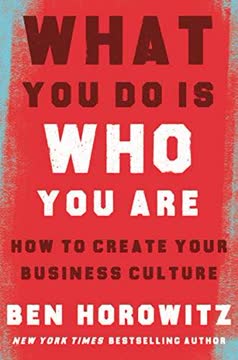Key Takeaways
1. Decentralized organizations are reshaping industries and society
Decentralization has been lying dormant for thousands of years. But the advent of the Internet has unleashed this force, knocking down traditional businesses, altering entire industries, affecting how we relate to each other, and influencing world politics.
Decentralized revolution. The rise of decentralized organizations is transforming various sectors, from music and software to social movements and terrorism. Examples include:
- Napster and peer-to-peer networks disrupting the music industry
- Wikipedia challenging traditional encyclopedias
- Craigslist upending classified advertising
- Al-Qaeda presenting new challenges to national security
Impact on traditional structures. Decentralized systems are often more resilient, adaptable, and difficult to control than their centralized counterparts. This shift is forcing established institutions to rethink their strategies and adapt to a new landscape where power is distributed rather than concentrated.
2. The starfish analogy: Understanding decentralized systems
If you cut an arm off, most of these animals grow a new arm. And with some varieties, such as the Linckia, or long-armed starfish, the animal can replicate itself from just a single piece of an arm.
Starfish vs. spider organizations. The book introduces a powerful analogy to differentiate between centralized and decentralized systems:
- Spider (centralized): Has a head, hierarchical structure, vulnerable if head is removed
- Starfish (decentralized): No central brain, distributed network, can regrow from parts
Key characteristics of starfish organizations:
- No clear leader or hierarchy
- Knowledge and power distributed throughout the system
- Resilient to attacks or attempts to shut them down
- Ability to mutate and adapt quickly
3. Catalysts: The hidden power behind decentralized movements
A catalyst is the person who initiates a circle and then fades away into the background.
Role of catalysts. Catalysts are crucial to decentralized organizations, but their leadership style differs significantly from traditional CEOs:
- Inspire and connect people rather than giving orders
- Transfer ownership and responsibility to the circle
- Lead by example and ideology rather than authority
- Often remain behind the scenes or fade away after initiating movement
Catalyst tools:
- Genuine interest in others
- Ability to map social networks
- Desire to help and connect people
- Emotional intelligence
- Trust in the network
- Tolerance for ambiguity
4. The five key elements of successful decentralized organizations
The Starfish and the Spider represents an important framework for understanding and mastering distributed leadership.
The five legs of decentralization:
- Circles: Small, autonomous groups that form the basic unit
- The catalyst: Initiates and inspires but doesn't control
- Ideology: Shared beliefs that hold the organization together
- Pre-existing network: Platform on which the organization can grow
- The champion: Relentlessly promotes and implements ideas
Importance of balance. Successful decentralized organizations need all five elements working together. Losing one or two legs may not destroy the organization, but having all five creates a powerful and resilient system.
5. Ideology and pre-existing networks fuel decentralized growth
Ideology is the glue that holds decentralized organizations together.
Power of shared beliefs. A strong ideology provides:
- Motivation for members to contribute without traditional incentives
- Common purpose that unites diverse individuals and groups
- Resilience in the face of challenges or attacks
Leveraging existing platforms. Decentralized movements often grow rapidly by tapping into:
- Established communities with shared values (e.g., Quakers for abolition movement)
- Technologies that enable easy connection and collaboration (e.g., Internet for P2P networks)
Examples of ideological drivers:
- AA: Belief in mutual support for overcoming addiction
- Wikipedia: Faith in collaborative knowledge creation
- Open-source software: Commitment to free and accessible technology
6. Hybrid organizations: Balancing centralization and decentralization
Companies like eBay combine the best of both worlds—the bottom-up approach of decentralization and the structure, control, and resulting profit potential of centralization.
Types of hybrid organizations:
- Centralized company with decentralized customer experience (e.g., eBay, Amazon)
- Centralized company that decentralizes internal parts of the business (e.g., GE under Jack Welch)
Benefits of hybrid approach:
- Harnesses creativity and adaptability of decentralization
- Maintains structure and accountability of centralization
- Can be more competitive in rapidly changing industries
Examples of successful hybrids:
- eBay: Centralized company structure with decentralized user ratings and transactions
- Google: Centralized operations with algorithms relying on decentralized user input
- Toyota: Hierarchical structure with empowered, autonomous work teams
7. Finding the "sweet spot" in organizational structure
The decentralized sweet spot is the point along the centralized-decentralized continuum that yields the best competitive position.
Balancing act. Organizations must find the right balance between centralization and decentralization to maximize effectiveness and competitiveness.
Factors influencing the sweet spot:
- Industry characteristics
- Technology changes
- Customer preferences
- Regulatory environment
- Competitive landscape
Dynamic nature. The sweet spot is not static; it can shift over time due to internal and external factors. Successful organizations continuously reassess and adjust their position on the centralization-decentralization spectrum.
8. Strategies for combating decentralized opponents
When attacked, a decentralized organization tends to become even more open and decentralized.
Challenges of fighting starfish. Traditional tactics often backfire when used against decentralized opponents, making them stronger and more resilient.
Effective strategies:
- Changing ideology: Address root causes and shift beliefs (e.g., microfinance in slums)
- Centralize them: Introduce hierarchy or scarce resources (e.g., giving cattle to Apache leaders)
- Decentralize yourself: Fight starfish with starfish (e.g., creating decentralized counter-terrorism units)
Importance of adaptation. Organizations facing decentralized challengers must be willing to rethink their approach and potentially adopt hybrid or decentralized elements themselves.
9. The new rules of business in a decentralized world
We have entered a new world where being small can provide a fundamental economic advantage.
Shifting paradigms:
- Diseconomies of scale: Smaller can be better in networked environments
- Network effect: Value increases as more people use a product or service
- People power: Customers and users become co-creators and collaborators
- Rapid adaptation: Success depends on ability to quickly evolve and respond to changes
Implications for leaders:
- Embrace ambiguity and distributed decision-making
- Focus on facilitating rather than controlling
- Cultivate strong ideologies and shared purpose
- Leverage pre-existing networks and platforms
- Continuously seek the "sweet spot" between centralization and decentralization
Last updated:
FAQ
What's "The Starfish and the Spider" about?
- Decentralization vs. Centralization: The book explores the power and dynamics of decentralized (starfish) versus centralized (spider) organizations.
- Real-world Examples: It uses examples like Alcoholics Anonymous, Wikipedia, and al Qaeda to illustrate how leaderless organizations operate.
- Organizational Structure: The authors discuss how decentralized organizations can be more resilient and adaptable than traditional hierarchical structures.
- Impact on Industries: The book examines how decentralization is affecting various industries, including music, software, and telecommunications.
Why should I read "The Starfish and the Spider"?
- Understanding Modern Organizations: It provides insights into how modern organizations are evolving with decentralization.
- Strategic Insights: Offers strategies for businesses to adapt to or combat decentralized competitors.
- Innovative Thinking: Encourages readers to think differently about leadership and organizational structure.
- Relevance: The concepts are applicable to a wide range of fields, from business to social movements.
What are the key takeaways of "The Starfish and the Spider"?
- Decentralization's Strengths: Decentralized organizations are resilient, adaptable, and can grow rapidly.
- Catalysts' Role: Catalysts are crucial in starting and maintaining decentralized organizations but must eventually step back.
- Ideology's Importance: A strong, shared ideology is the glue that holds decentralized organizations together.
- Hybrid Models: Combining elements of both centralized and decentralized structures can be highly effective.
How do "starfish" and "spider" organizations differ according to the authors?
- Structure: Starfish organizations lack a central command, while spider organizations have a clear hierarchy.
- Resilience: Starfish organizations can survive the loss of a leader or unit, whereas spider organizations are vulnerable if their head is removed.
- Growth: Starfish organizations can grow rapidly and mutate easily, while spider organizations grow more slowly and are less flexible.
- Decision-Making: In starfish organizations, decisions are made collectively, whereas in spider organizations, decisions are top-down.
What is the role of a catalyst in a decentralized organization?
- Initiator: Catalysts start the organization by inspiring and connecting people.
- Non-controlling: They lead by example and do not impose control over the organization.
- Facilitator: Catalysts help establish the initial structure and culture but then step back to let the organization evolve.
- Trust Builder: They foster a culture of trust and collaboration among members.
How does "The Starfish and the Spider" explain the concept of the "sweet spot"?
- Balance: The sweet spot is the optimal balance between centralization and decentralization for an organization.
- Adaptability: Organizations must continually adapt to find and maintain this balance as external conditions change.
- Examples: Companies like eBay and Toyota are cited as examples of finding the sweet spot by combining decentralized user input with centralized control.
- Dynamic Nature: The sweet spot is not static; it shifts with technological and market changes.
What strategies does "The Starfish and the Spider" suggest for combating decentralized organizations?
- Change Ideology: Altering the ideology of a decentralized organization can weaken its cohesion.
- Centralize Them: Introducing property rights or centralized resources can shift a decentralized organization toward centralization.
- Join Them: Adopting a hybrid model that incorporates decentralized elements can be an effective strategy.
- Empower Local Knowledge: Utilize local knowledge and networks to counteract decentralized threats.
What are some real-world examples used in "The Starfish and the Spider"?
- Alcoholics Anonymous: Demonstrates the power of decentralized support groups.
- Wikipedia: Illustrates how user-generated content can create a comprehensive and reliable resource.
- al Qaeda: Used to show how decentralized cells can operate effectively without a central command.
- eBay: An example of a hybrid organization that combines decentralized user ratings with centralized operations.
What are the best quotes from "The Starfish and the Spider" and what do they mean?
- "The harder you fight a decentralized opponent, the stronger it gets." This highlights the resilience of decentralized organizations when under attack.
- "A leader is best when people barely know that he exists." Emphasizes the role of catalysts who lead by empowering others rather than through direct control.
- "The values are the organization." Stresses the importance of a shared ideology in maintaining the cohesion of a decentralized group.
- "Put people into an open system and they’ll automatically want to contribute." Reflects the natural human desire to share and collaborate in decentralized environments.
How does "The Starfish and the Spider" address the impact of decentralization on industries?
- Music Industry: Shows how P2P networks have disrupted traditional music distribution.
- Software Industry: Discusses the rise of open-source software as a decentralized alternative to proprietary systems.
- Telecommunications: Explains how services like Skype have challenged traditional phone companies.
- Newspaper Industry: Describes how platforms like craigslist have affected classified ad revenues.
What is the significance of the "accordion principle" in "The Starfish and the Spider"?
- Cyclical Nature: Industries and organizations tend to swing between centralization and decentralization over time.
- Response to Overcentralization: Decentralized systems often emerge as a response to overly centralized structures.
- Adaptation: Organizations must adapt to these shifts to remain competitive and relevant.
- Historical Context: The principle is illustrated through historical examples, such as the evolution of the music industry.
How can businesses apply the concepts from "The Starfish and the Spider"?
- Embrace Decentralization: Incorporate decentralized elements to foster innovation and adaptability.
- Leverage Networks: Utilize the network effect to enhance value and customer engagement.
- Balance Control and Freedom: Find the sweet spot between centralized control and decentralized freedom.
- Focus on Ideology: Cultivate a strong, shared ideology to unite and motivate employees and customers.
Review Summary
The Starfish and the Spider explores decentralized organizations' power and resilience compared to traditional hierarchies. Readers found it thought-provoking, with engaging examples and valuable insights into leadership and organizational structure. Some praised its potential for transforming businesses, while others felt it lacked depth or relied on outdated examples. The book's accessible style and focus on empowering human initiative resonated with many, though some wished for more practical implementation advice. Overall, readers appreciated its fresh perspective on organizational dynamics and adaptability in changing markets.
Similar Books










Download PDF
Download EPUB
.epub digital book format is ideal for reading ebooks on phones, tablets, and e-readers.





